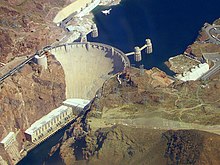
An arch-gravity dam or arched dam is a dam with the characteristics of both an arch dam and a gravity dam. It is a dam that curves upstream in a narrowing curve that directs most of the water pressure against the canyon rock walls, providing the force to compress the dam. It combines the strengths of two common dam forms and is considered a compromise between the two. They are made of conventional concrete, roller-compacted concrete (RCC), or masonry. A typical example of the conventional concrete dam is the Hoover Dam. Changuinola Dam is an example of the RCC arch-gravity dam. A gravity dam requires a large volume of internal fill. An arch-gravity dam can be thinner than the pure gravity dam and requires less internal fill.
Overview

Arch-gravity dams are dams that resist the thrust of water by their weight using the force of gravity and the arch action.
An arch-gravity dam incorporates the arch's curved design which is effective in supporting the water in narrow, rocky locations where the gorge's sides are of hard rock and the water is forced into a narrow channel. Therefore, the span needed for the dam is also relatively narrow, and the dam's curved design effectively holds the water back while using less construction material compared to a pure arch dam or gravity dam. These dams are more reliable than arch dams. Typically, arch-gravity dams are built in canyon-like terrain, with the surrounding cliffs serving as supporting walls. An arch-shaped bank-fill dam reduces the overall mass of the structure and the cost of construction compared to purely gravity dams. Arch dams and arch-gravity dams are most commonly used in hydraulic structures of more than 100 m in height.
See also
Footnotes
- Samartín, Avelino; Fuente Martín, Pablo de la; Plaza, Luis F.; Penas, Jesús (1998). "Preliminary design of symmetric arch-gravity dams". In Berga, L. (ed.). Dam Safety: Proceedings of the International Symposium on New Trends and Guidelines on Dam Safety, Barcelona, Spain, 17–19 June 1998. Balkema. pp. 425–432. ISBN 978-90-5410-975-4.
- "Arch Gravity dam". U.S. Bureau of Reclamation. Archived from the original on 25 December 2007. Retrieved 2007-12-27.
- "Glossary onf Engineering Words - Gravity dam". pbs.org. Archived from the original on 30 December 2007. Retrieved 2007-12-28.
- "Dam Basics". pbs.org. Archived from the original on 3 December 2007. Retrieved 2007-12-27.
- "Bureau of Reclamation Engineering Achievements". nps.gov. Retrieved 2022-11-17.
Further reading
- Malla, S; Wieland, M (July 1999). "Analysis of an arch–gravity dam with a horizontal crack". Computers & Structures. 72 (1–3): 267–278. doi:10.1016/S0045-7949(99)00033-4.
- Valente, Silvio; Capriulo, Chiara; He, Qi (June 2019). "A compression-shear fracture growing on an arch-gravity dam". Theoretical and Applied Fracture Mechanics. 101: 178–184. doi:10.1016/j.tafmec.2019.02.011.
- Колосова, Галина Сергеевна; Лалин, Владимир Владимирович; Колосова, А.В. (August 2013). "Влияние строительных швов и трещин на напряженно-деформированное состояние арочно-гравитационной плотины" [The effect of construction joints and cracks on the stress-strain state of the arch-gravity dam]. Инженерно-строительный журнал [Magazine of Civil Engineering] (in Russian). 40 (5): 76–85. doi:10.5862/MCE.40.9. ProQuest 1446486592.